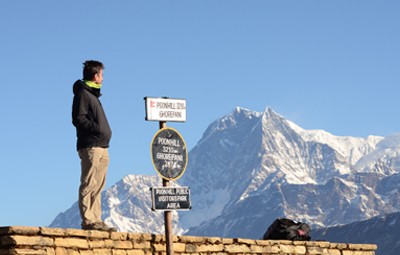Trekking In Nepal: Ghorepani Poon Hill
First of all, Nirajan recommended the most suitable travel plan based on my preferences, physical fitness, and budget. Since arriving in Kathmandu, he has looked after every tiny detail throughout the journey. Trekking was the main part of my nearly 4-week itinerary. After staying in Kathmandu for a night, we set off on a 5-day walk on Ghorepani Poon Hill, a mountainous area around Pokhara. Bearing in mind the high altitude of Nepal, the domestic airports were limited to small planes. Thus, the only choice was to fly nervously in a less than 20-seater propeller plane; and we just had to fearlessly leave ourselves to the aviation professionals. The short stay at Pokhara for a day before the trekking had given me a precious opportunity to learn a bit of the Nepali culture, customs, language, and food. This is the second-largest city in Nepal and also has beautiful scenery, overlooking the magnificent Annapurna Mountain Range.
The first-day trekking started from Nayapul at 1,050 m and stopped over at Tikhedunga up to Ulleri at 1,900 m, i.e., approximately 15 km of less than a 5-hour walk. The speed seemed slightly slow, but it was a good feeling to be surrounded by the high mountains. Well, there was no need or anything to compete for, and I was just learning to keep a steady walking pace. I could walk freely with empty hands, as Tul was always helping me carry my luggage. The food in the mountains was unexpectedly good. Besides Nepali meals, a variety of international food was provided. There was indeed no need to bring our own Facebook!
By chatting with me, Nirajan monitored my mental and physical status. He tailor-made the trekking schedules for me without leading to any physical stress, though the elevation was from 1,900 m in Ulleri to 2,860 m in Ghorepani on the second day. It took me less than 4 hours to finish the 13-kilometer walk. A checkpoint was in the middle. It was also good that a pre-registration/application for a trekking permit was done in advance, making the journey even smoother. Preparation is perfect!
The highlight of the trekking journey was seeing the sunrise from the viewpoint of Poonhill at 3,210 m. We started hiking at 4:30 am. It was dark and cold, and it took us more than an hour to reach the observatory platform. It was crowded. Soon after, darkness broke. The majestic scenery left us breathless. We spent hours enjoying this splendid and spectacular view—the magnificent panorama of light with which the sun awakens the sleeping mountains. We took tremendous photos, and we were the last group saying goodbye to Poonhill that morning. On returning to the tea house for breakfast, almost all the hikers had left, and it was good to be exclusively served!
As the next trial was descending from Ghorepani at 2,860 m to Tadapani at 2,680 m, I was advised to use 2 trekking poles. My straightforward reaction then was to follow in order not to offend Nirajan. But, in the end, it worked very well that way. Following the advice of the professionals was one of the many things I learned from this trip. The journey continued for another 20 km, a 5-hour walk, ascending and descending, and walking along the river felt like being in a sub-tropical region. Though it was the longest walking day, it was also the most rewarding. The magnificent views from sunrise to sunset were enjoyable. Encountering the local people and seeing the wildlife along the trails were pleasurable. It was an excellent feeling to enjoy a bowl of home-made noodles at the end of the day!
The Tadapani gives a closer view of the Annapurna Mountain Range. Taking photos of the sunrise had become a must-do item on the list for every morning. After breakfast, we headed to Ghandruk at 1,940 m, where we spent the last night in the mountains. It was the easiest walk of the trip, descending all the way. It lasted more than 3 hours of walking at a steady pace for 13 km. I could hear the rhythm, and it felt great!
The last day of the trek began with a cup of milk and breakfast with my usual sliced butter on toast. We departed from the Malaysian group we met almost every day during the trip before heading to Kimche at 1,640 m. The 300-meter descending trail took us just an hour to walk. Obviously, my body had acclimatized to the altitude, and I was able to walk faster! The trip ended with a jeep drive back to Pokhara. It was far better than taking a public bus, which was a wise choice suggested by Nirajan.
The sunny weather, fresh air, and pleasant temperature have made the trekking an enjoyable experience. Indeed, trekking is both a pleasurable and a fitness activity. Even though some of the ten participants in the Malaysia group had no previous trekking experience, they were able to finish the trekking tour. I am sure anyone can do the same.
I highly recommend trekking in Nepal to everyone, particularly Rugged Trials Nepal and their partners, for their thoughtful and professional service. This is certainly an agent that one can rely on.

